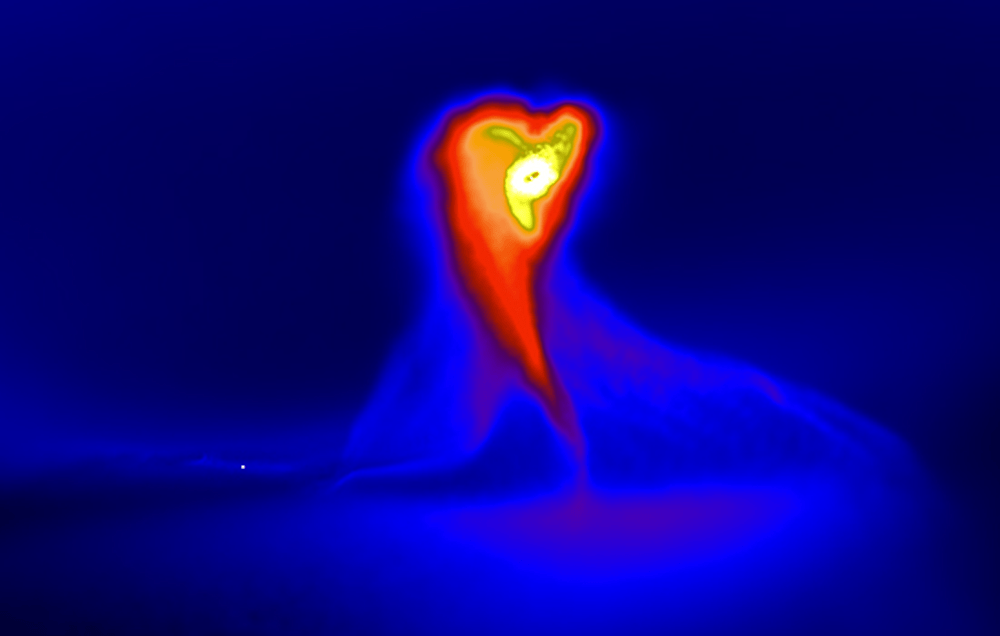What causes an otherwise unremarkable star to become over 100 times brighter? That’s a question astronomers have been pondering since 1936, when a star in Orion brightened from 16th magnitude to 8th magnitude in a single year.
The star, named FU Ori, is still bright to this day. Astronomers have come up with different explanations for the star’s brightening, but none of them provides a complete explanation.
Now we might have one.
A new study titled “On the rise times in FU Orionis events” presents an explanation for FU Ori. It’ll be published in the Monthly Notices of the Royal Astronomical Society. The lead author is Elizabeth Borchert, a PhD candidate at the Monash School of Physics and Astronomy.
“Many explanations have been proposed, but none completely explain the phenomenon,” said Borchert in a press release.
Astronomers know now that FU Ori isn’t the only one of its kind; just the first. The FU Orionis class of stars is named after it. They’re T-Tauri stars, which means they haven’t entered the main sequence yet. They’re still ensconced in the mass of gas and dust that they formed out of, and that planets will form in. And that fact helps explain the brightening.
One of the explanations for FU Ori involves binary interactions between two stars. In 2004 that idea grew stronger when astronomers realized the FU Ori is actually two stars: FU Ori N, the star that brightened, and FU Ori S. The astronomers who found FU Ori S think it’s likely also a pre-Main Sequence star.

Astronomers now know that FU Ori N, the original star that brightened in 1936, is not the primary star in the pair. Instead, FU Ori S is the primary star, with about 1.2 solar masses. Fu Ori N is approximately 0.3 to 0.6 solar masses.

Follow-up studies in the years since the 2004 work show that FU Ori’s disk has experienced perturbations due to binary interactions. The team behind this work wanted to find out if a flyby of one star into the other’s disc could account for FU Ori’s historical brightening, and the brightening of other FU Orionis Stars. “Our main aim is to test whether a stellar flyby that penetrates the disc can produce a fast-rising but long-lasting outburst,” they write in their paper.
The team performed 3D hydrodynamic simulations

When the secondary star passes through the primary’s disc, it experiences a prominent spike in accretion. In their simulations, there’s no disc surrounding the secondary until it passes through the primary’s disc. “We observe a fast rise of the mass accretion rate onto the secondary in all simulations where the secondary penetrates the disc,” the authors write.

When FU Ori brightened in 1936 it did so in a year. For an astronomical event that is a remarkably small amount of time. How can that rapid rise be explained?
“We can understand the rapid timescale as follows: While the primary receives its accretion outburst from inward evolution of disc disturbances, the secondary goes into outburst when penetrating the disc of the primary, capturing material and accreting rapidly due to direct cancellation of angular momentum,” they write. The accretion burst … is sustained for more than 100 years by ongoing infall onto the circumsecondary disc from the surroundings.”
“We show that another star crashing into the surrounding disc of gas and dust results in 250 times change in brightness in one to two years,” said co-author Associate Professor Christophe Pinte, also from the Monash School of Physics and Astronomy.
“The surprise of the study was that the small star is the one that becomes bright, which is nice as in FU Ori the low-mass star is the bright one of the pair,” Borchert said.
These disc interactions may explain something we find in our own Solar System: chondrules. They’re round droplets of once-molten material found in chondrites. Chondrules are melted in space as droplets before accreting onto their parent asteroids. Could FU Ori disc interactions account for chondrules?
In their simulations the team saw temperature rise above 1500 Kelvin. “Interestingly, such rapid heating of the disc with dust melting could possibly explain the existence of chondrules in our solar system, where dynamical evidence for a past flyby exists.” they write. “Flash heating occurs to some extent around both stars, so evidence for similar heating in the solar system does not necessarily imply that our Sun was the perturber.”

“A mystery in our solar system is that a lot of the dust found in meteorites seems to have been melted rapidly, which could be explained by a similar disturbance to our solar system during its formation,” said study co-author Professor Daniel Price, also from Monash School of Physics and Astronomy.
Does this study prove that binary disc interactions are responsible for FU Orionis stars and their brightening? The team wasn’t able to completely reconstruct FU Ori’s 1936 brightening, but it does show that disc interactions could be responsible.
“In our simulations we have not attempted a detailed reconstruction of the close encounter in FU Orionis. This is the likely reason we are not yet able to maintain the outburst exactly as seen in FU Ori,” they write in their conclusion.
But they have shown that disc interactions could be the cause. Their simulations repeated the fast rise in luminosity, the higher accretion rate experienced by the secondary star, and the lower mass star experiencing an outburst.
More:
- Press Release: Astronomers find clue to solar system formation through well-known star
- New Research: On the rise times in FU Orionis events
- Universe Today: Both Stars in This Binary System Have Accretion Disks Around Them

